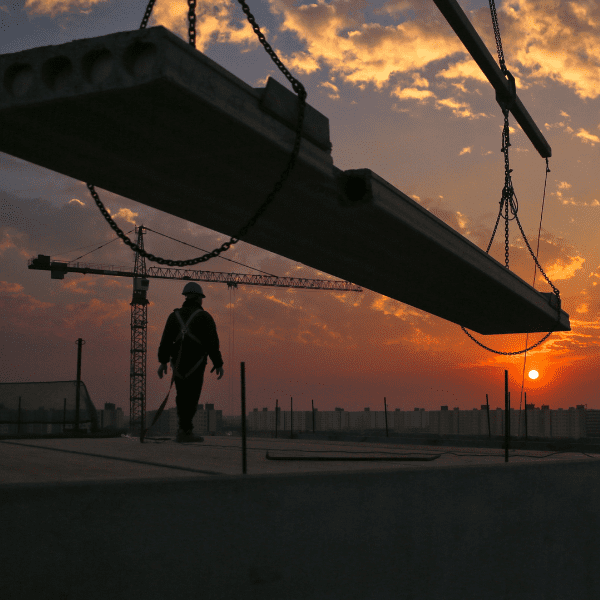Summary
- NextGenerationEUrepresents an opportunity for Irish companies to break into new markets or scale their presence in existing markets.
- EU member states are united in the push for a carbon-neutral Europe by 2050, which requires huge investment in sustainable construction and retrofitting.
- Click or scroll down for more information about the sustainable construction market in:
Sustainability is the future of construction. Since the 2015 Paris Agreement (or COP 21), countries around the world have been striving to change how they operate with a view to keeping global warming at 2C or lower. In many countries, the decarbonisation of construction comes second only to renewable energy as the sector where most impact can be had.
Concrete and cement alone account for as much as 8 percent of global CO2 emissions, while the construction industry is also a heavy consumer of energy and other resources and generates huge levels of waste. Furthermore, existing building stocks across the region emit carbon and need to be retrofitted to operate sustainably.
The push for a carbon neutral 2050
Through the €806.9 billion Recovery and Resiliency Facility (RRF), which aims to help Europe recover from the pandemic and future-proof its economy and society, the European Union also hopes to achieve its Green Deal target of climate neutrality by 2050.
“We are all on the same page in Europe,” says Alix Derigny, Market Advisor Construction & Sustainable Build at Enterprise Ireland in France, “because every state has set greenhouse gas emission-reduction targets. The EU and national governments are putting in place grants to raise ambitions, and consumers are expecting day-to-day life to be greener.”
“Similarly, the real estate and retail sectors are putting pressure on the construction sector to accelerate the ecological transition. This issue is driving all businesses in the sector, from sub-contractors to suppliers and materials manufacturers.”
In fact, at least 37% of spending in the national plans funded by the RRF must relate to climate goals. Much of that, in turn, is going to construction and infrastructure projects.
In the effort to build a truly climate-friendly, circular economy, where waste and carbon emissions are minimised or eliminated, building and renovation methods are crucial. Prefabrication, for example, can enhance efficiency and build speed, while minimising waste.
Across the board in Europe, governments are making use of this funding to enable the Green transition. From a construction perspective, this includes work around:
- energy retrofitting of public and private buildings, including homes and business premises
- enabling the circular economy, through the modernisation of recycling centres and other projects
- building green infrastructure, such as rail and other transport infrastructure.
Where the opportunity lies for Irish construction firms
As the whole industry evolves to embrace innovation, be more flexible, efficient and sustainable, many opportunities are opening up for contractors, engineering and advisory companies. It’s worth bearing in mind that large contractors are now seeking to reduce emissions across their entire value chain and will seek vendors who can meet those standards.
Irish firms are already delivering demanding construction and related projects in more than 100 countries. Ireland has particular strength in sought-after capabilities such as:
- designing and delivering advanced infrastructure across the data, pharma and energy sectors
- developing and implementing innovative digital and data-driven solutions, such as digital twins
- improving resource efficiencies
There are a number of key areas in which the construction sector across Europe, and indeed globally, will welcome the solutions Irish firms can provide. “Markets like France and Germany are mature markets with an engineering culture,” says Derigny.
“You need to be innovative or have something to reduce the customer’s carbon footprint, if you want to compete with domestic suppliers,” she adds. “If you can bring those solutions, you’ll find customers with a huge appetite for them.”
Specific areas of interest to European construction customers include:
- energy efficiency
- sustainable heating, ventilation and air conditioning (HVAC) systems
- LEED certification
- smart building solutions, including sensors, security and maintenance
- 5G Technology (for IoT solutions)
- technologies and material to reduce CO2 emissions
- solar panels
- AI-powered solutions
- any other product or service that can help lead to Leadership in Energy and Environmental Design (LEED) certified buildings
Partners and planning vital to success
Typically, says Derigny, it makes sense for Irish firms to find partners in export markets, because it increases speed to market and reduces risk, but Enterprise Ireland can advise on a case-by-case basis.
Across Europe, as for any market at present, this sector is grappling with commodity price inflation, supply chain disruption and labour shortages. None of the markets below varies from that perspective, so it’s best to be prepared and consider how you can surmount these challenges so your market entry is not derailed by external factors.
Understand the 5G market opportunity for Irish firms
The strong Irish cluster of cybersecurity firms, for example, has clear opportunities across key European markets as do Irish firms specialising in Open RAN, a technology that facilitates the deployment of 5G. Other thriving areas where Enterprise Ireland has identified significant opportunities for Irish firms include IoT and smart cities.
Among the Irish firms specialising in 5G and connectivity products and services, and thriving in EU markets, are Open RAN radio infrastructure specialists Benetel or Aspire and core cellular network software company Druid Software.
Expert advisors in Enterprise Ireland’s network of offices across Europe, together with its Market Research Centre in Dublin, can support your business as it investigates market opportunities, including by making local introductions and helping you to build your network.
If you are not sure where to start your export journey, get in touch.
Market snapshots
France
The renovation sector is thriving in France as established building and energy firms seek innovative solutions to incorporate into their offerings.

Germany
Huge drive for energy-efficient building and renovation represents a significant opportunity for Irish firms prepared to commit to the German market.

Italy
Opportunities abound for construction firms in Italy, where the government is committed to upgrading its building stock and overhauling its infrastructure.




